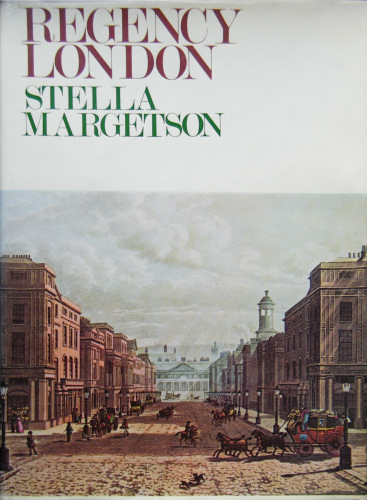Nonfiction Book Reviews
- Prince of Pleasure
- My Dear Cassandra
- Mirror of the Graces
- The Complete Servant
- The Regency Road
- Life in Regency and
Early Victorian Times - Regency London
- Regency Gardens
- Beau Brummell
- Age of Revolution
- Caroline & Charlotte
Regency Fiction
Historical Facts

Title: Regency London, book 4 in Cassell's London series
Author: Stella Margetson
First published 1971 in Britain by Cassell. USA edition printed 1971 by Praeger.
ISBN: 0304938165, 9780304938162
153 pages, illustrated throughout with b/w photos, drawings and maps.
Excerpt (Chapter 1):
Regency London was the gayest, the most opulent and the most fashionable city in Europe. It had vigour, liveliness and style. The streets in the West End in the Season were crowded with elegant carriages: stanhopes as high as a first-floor window, tilburies, curricles, tandems, tim-whiskies and phaetons, drawn by superbly glossy, thoroughbred horses. In St James' and Piccadilly, the dandies strolled up and down, impeccably dressed in their skin-tight 'trowsers' and high 'starchers', going to White's or to Watier's to play at faro, whist and hazard. In the leafy glades of Hyde Park, the highbred ladies of the ton and the high-priced and pretty demi-reps of the town drove out at the fashionable hour of five, and later in the evening both were to be seen with plumes in their hair, coquetting in the boxes at the Royal Italian Opera House in the Haymarket. Catalani, Bianchi and Naldi were singing at the Opera; Edmund Kean was acting at Drury Lane; Lord Byron dining on vinegar and potatoes with Samuel Rogers in St James' Place; Keats walking from Hampstead across the fields to Lisson Grove to visit the painter Benjamin Robert Haydon. And the Prince Regent himself (fig. 1), that 'most extraordinary compound of talent, wit, buffoonery, obstinacy and good feeling', might have been found drinking cherry brandy in the overheated drawing-room of Carlton House, or closeted with his favourite architect, John Nash, discussing some new and grandiose building scheme to transform London into a city worthy to rank with the splendour of Imperial Rome.
Review
Many years ago… Although always having a keen interest in history, it was the Regency romance novel that made me take a closer look at London of the early 19th Century. While wondering about the authenticity of people and places, I was lucky enough to stumble upon this absorbing book in my local library. I doubt there is a single missing significant place or major historical figure - and some of the minor ones too - with any connection to London of the era, from Prinny (The Prince Regent and future George IV) down to the street sweeper. The book is filled with quotes from identified historical persons, which lends an added creditability to the text.
A picture is said to express a thousand words and this book is illustrated throughout with a multitude of reproduced historical drawings, etchings, caricatures and maps, as well as paintings and old photographs. You get a glimpse of every sphere in society, from the sumptuous regal Carlton House to the East India docks, from attending an exhibition by The Royal Academy to viewing the inside of a Covent Garden gin shop. The simple index is also of some help in locating notable people and places.
On the negative side, except for attributed quotes, not a single source is listed; there is not even a select bibliography or literature list. Like all works of this kind there are some potential factual errors, which cannot be, for obvious reasons, easily verified. As well, the addition of a glossary and a separate person index would greatly enhance this work. Yet, as a fast-paced introduction to the Regency world of Georgette Heyer and the Regency novel, this book is still an excellent choice.
- Carton House
- The Mercantile City
- Westminster and the Government
- The Regent and his Architect
- High Society
- Entertainment
- The Arts and the Writers
- The Populace
- Some Visitors to London
- An Expanding City
Index
Index
ContentsIllustrations